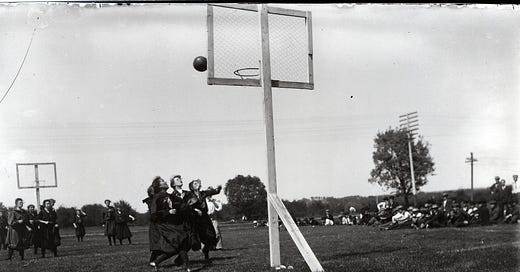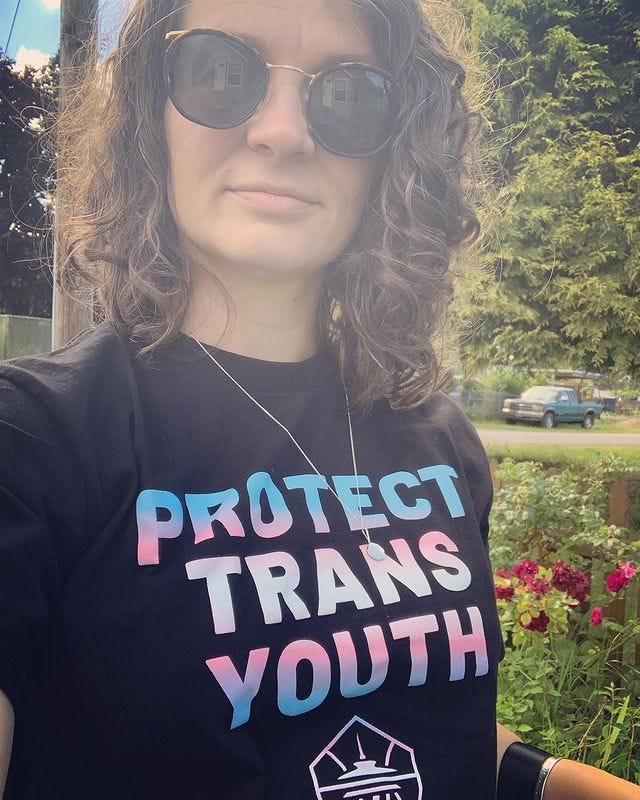OK, I’ve been thinking about the importance of telling women’s stories, and of knowing our own history in these past couple (and upcoming) newsletters. And I had a whole other thing planned for this week, but then I was on deadline and then I went to the Seattle Storm home opener on Tuesday evening and I was just so happy and reminded why I love women’s sports and why I’ve always come back to writing about them. And anyway, I thought I’d just give a little primer/history lesson on the league this week because, after all, women’s sports are having “a moment.” And you can join those of us who have been in this “moment” for years already. Truly, you can. We’re fun. I promise.
Caitlin Clark! The Golden State Valkyries! Angel Reese! Cameron Brink! The outfits! Women’s March Madness! The drama! If you’re new to the very exciting and wonderful WNBA: Welcome! Here’s a little helpful background context and history from your local sports-loving feminist culture writer.
The Teams!
There are currently 12 teams in the WNBA. They play 40 games each, from May to September. Playoffs go into October (and don’t last 100 years like NBA playoffs do). In fact, they go quick, and are usually HIGH drama. The Las Vegas Aces are the current superteam, and have won back to back championships.
When the league was founded in 1997, there were 8 teams: The Charlotte Sting, Cleveland Rockers, Houston Comets, New York Liberty, Los Angeles Sparks, Phoenix Mercury, Sacramento Monarchs1, and Utah Starzz. The Rockers, Sting, Comets, and Monarchs all have folded. Other teams that were added in 2000 but folded in 2002 were: Miami Sol, Portland Fire.
Today, we still have the Liberty, Sparks, and Mercury of the original 8. Additionally, now the league includes: Atlanta Dream, Chicago Sky, Connecticut Sun (formerly Orlando Miracle), Indiana Fever, Washington Mystics, Dallas Wings (formerly the Detroit Shock, then the Tulsa Shock), Las Vegas Aces (formerly the Utah Starzz, then the San Antonio Stars), Minnesota Lynx, and Seattle Storm.
Expansion is happening and this is super exciting! The Golden State Valkyries, will join in 2025, and Toronto will join in 2026. The league commissioner has said that they hope to get to 16 teams in the next few years. Rumors abound!
The $$$
Yes, the salaries are low, very low, compared to the NBA. In fact, the highest paid WNBA players make 0.05% of the highest NBA salaries. Rookies in the WNBA make between $64,000 and $76,000. Super max salaries in the WNBA are a bit above $200,000. The last CBA for the league was approved by players in 2020 and these were actually a pretty huge jump from the previous agreement.
When the league started in 1997 as an official part of the NBA, the women’s league played a 10-week season, and the salaries ranged from $15,000 - $50,000. (Lisa Leslie. Sheryl Swoopes. Rebecca Lobo. Those icons were paid 50k max).
In 1999, the first WNBA CBA was agreed to, which marked the first ever collective bargaining agreement in women’s sports. That agreement raised minimum salaries to $25,000 for rookies and $30,000 for veterans.
Players’ current CBA runs through 2027 but there is an option for the players to opt out and renegotiate earlier, which may very well happen, especially as massive increase in attention to the league points to the need for more investment and more potential revenue. The league has also, reportedly, doubled its revenue in just the past four years.
You may have heard about Brittney Griner being detained in Russia two years ago and wondered how that happened. Many many players have played and continue to play in foreign leagues during the “offseason” which is really often longer than the WNBA season. They often make far, far more money overseas. The top markets for foreign players historically were: Turkey, China, and Russia. Today many play in Australia, France, Italy, etc. because safety concerns in the other leagues have become such a problem.
Of course, yes, many of these women are able to make endorsement money on top of their salaries. However, so do male athletes, and we don’t dock their pay for it!
The NBA’s Role
The NBA used to fully own and subsidize the WNBA when the league first launched. But in 2002, the NBA announced they would no longer subsidize the league and sold the WNBA teams off as individual franchises. Today, about half of WNBA teams are owned by the same ownership group as an NBA team: New York Liberty, Indiana Fever, Minnesota Lynx, Phoenix Mercury, Washington Mystics (and the future Golden State Valkyries) all share ownership groups with their local NBA teams. Whereas the other teams are owned by independent ownership groups (even if they have a local NBA team): Chicago Sky, Seattle Storm, Las Vegas Aces, Atlanta Dream, Los Angeles Sparks, Connecticut Sun, and Dallas Wings. They are also, most likely, all vastly undervalued by investors.2
Now, the league itself, the WNBA league, is owned by the 12 team’s owners and the NBA owns a stake (the organization that also owns the NBA G League, NBA 2K League, and the Basketball Africa League). They also sold a $75 million stake in the league last year to a group of investors who now owns 16% of the league. This is kind of confusing, I know, and it doesn’t seem all of the exact numbers are public. But those in the know say Adam Silver (the NBA commissioner) is ultimately the one who can make decisions about the WNBA.
FWIW, NBA players have become extremely vocal about supporting the women’s game in recent years. Which has been amazing to see, not because men’s validation is the most important thing, but because the players respect the game and see the talent and often speak out on pay inequities being ridiculous.
The Talent
Because the WNBA is so much smaller than the NBA, only 12 teams compared to 30, and smaller roster sizes (15 compared to 12), and yet the college talent pool has only grown and grown in recent years (as has the international talent pool!) the talent is far more highly concentrated in the WNBA. Many of those cream of the crop college players that get drafted every year won’t even make a WNBA roster right away. They might go play internationally and try again in a year or two, or they may just pursue other opportunities. Hopefully this changes with league expansion, because getting drafted but not actually making a team is pretty shitty!
Even though the WNBA is only 27 years old, the WNBA wasn’t the first women’s basketball league. Women have been playing basketball just about as long as men have, but they were often stymied by lack of funding, investment, and competition opportunities. The ABL, an independent league, launched in 1996, but folded a few years later. Before that there were other leagues and barnstorming teams, and of course there are the international leagues. This history is really interesting and maybe I’ll write more about it another time.3
Please know that Caitlin Clark, while incredible, is not the first superstar to come into this league. If you become a fan there are absolute All-Stars on every team and always have been. You like 3-point shooters? Try Jewell Loyd, Breanna Stewart, or Sabrina Ionescu. Good defense? Check out Brittney Griner. A’ja Wilson, and Elizabeth Williams. Here for the drama and trash talk? Watch Diana Taurasi, Kelsey Plum, and Mabrina Mabrey.
The Fans
WNBA fans are so so so amazing. I’ve written about fanbases in the WNBA and I’ve been attending Storm games myself for years and years. It’s a completely different vibe than other professional sporting events you might be used to attending. Think older, queerer, more women, more little kids, but also just more positive energy. That doesn’t mean these fans don’t know their shit about basketball — they do. But also, if you don’t, you are also welcome! A great example of the demographics in Seattle fans were revealed at opening night on Tuesday. When the jumbo screen was showing famous people in the crowd, the Mayor of Seattle Bruce Harrell, (who’s kind of the Seattle version of Eric Adams), got polite applause with a smattering of boos. Former Seattle Seahawk and local favorite, Doug Baldwin got a big cheer, and NWSL’s Seattle Reign coach Laura Harvey got the biggest roar of support. It’s a strange and beautiful place!!!
Since I started going to WNBA games regularly it’s actually really hard for me to go to MLB games or other men’s sporting events anymore. Not because I don’t still enjoy the sports, I do. But the crowds are so horrific. You won’t hear toxic, racist, misogynystic bullshit at WNBA games, or have men ask you “if you even know the rules,” and that is why it’s basically feminist paradise.
The league puts its money where its mouth is. This is a league of majority Black, majority queer, women. They are the first league to embrace Pride nights wholeheartedly. The teams and players aren’t afraid to support LGBTQ+ issues, women’s issues, BLM, and politics on t-shirts and in fundraising and support. 4
(my favorite official Seattle Storm merchandise shirt I own)
Thanks for reading! My So-Called Feminist Life is a weekly newsletter wrestling with feminism in today’s world. I encourage conversation in the comments if you wish to share your own thoughts, feelings, memories, opinions. If you’d like to support this project financially, you can become a paid subscriber.
You can find me on Instagram: @maggiejmertens
Pre-order my book Better, Faster, Farther: How Running Changed Everything We Know About Women (Algonquin Books, June 18, 2024) from your favorite local bookstore, request it from your local library, or push this quick pre-order button from Bookshop.org
Yes, the Valkyries will be the Bay Area’s second chance at WNBA success!
Shattering the Glass: The Remarkable History of Women’s Basketball by Pamela Grundy is an exceptional read







“Since I started going to WNBA games regularly it’s actually really hard for me to go to MLB games or other men’s sporting events anymore. Not because I don’t still enjoy the sports, I do. But the crowds are so horrific. You won’t hear toxic, racist, misogynystic bullshit at WNBA games, or have men ask you “if you even know the rules,” and that is why it’s basically feminist paradise.”
YES. I went to a Sky/Sun game once and the teen boy behind me was heckling Candace Parker in a way that fans in the W just don’t do, even to opposing players, and he was put in his place by the fans around him.
This is great stuff. It really is a special league.